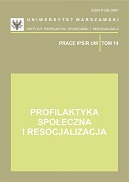Zachowania proksemiczne i zatłoczenie a funkcjonowanie zamkniętych instytucji resocjalizacyjnych
Proxemic Behaviour and Crowding vs. Functioning of Closed Resocialisation Institutions
Author(s): Dariusz SchmidtSubject(s): Social Sciences
Published by: Instytut Profilaktyki Społecznej i Resocjalizacji UW
Keywords: educational process; proxemic behaviour; proxemics; resocialisation institutions; spatial aspect of corrective institution
Summary/Abstract: The article presents quite an exotic issue as far as Polish resocialisation thought is concerned, namely proxemic dimension of closed corrective institution and its importance for the efficiency of educational process. It is emphasized in the subject literature that the so called “zero” (or often “minus”) effect of the resocialisation conducted in such conditions results not only from the defectiveness of the corrective process or from inmates’ disobedience but it is often imposed by adverse properties of closed educational environments such as youth educational establishments, reformatories or penitentiary units. One of the aspects that may be of importance to this process is spatial aspect of corrective institution, which is a subject of interest of proxemics, the science dealing, among others, with a man’s use of space for communication purposes. The necessity of tolerating constant presence of others and depriving inmates of privacy results, in Polish reality, from poor architectural conditions of the corrective units and from the fact that the sentence is served in multi-person cells. So far it has been boiled down to the matter of overpopulation which is an excessive simplification as in fact it concerns a wide range of phenomena connected with violation of personal territory and spatial distance or with entering one’s body’s buffer zone. It is also connected with the phenomenon of overcrowding. Territoriality instincts make inmates defend what they call their own territory and personal space once they experience inconvenience connected with limitation of their living space. It triggers aggressive and very violent reactions, which lead to disorganization not only of the inmate’s psycho-social functioning but also of the whole institution. It also makes inmates focus on initiating adequate self-defence mechanisms and countermeasure techniques instead of making them focus on more or less vague prospect of social rehabilitation. Thus the spatial aspect of corrective institution, which in Polish reality is still a “hidden dimension”, limits distinctively the efficiency of educational influence.
Journal: Prace Instytutu Profilaktyki Społecznej i Resocjalizacji
- Issue Year: 2009
- Issue No: 14
- Page Range: 89-125
- Page Count: 37
- Language: Polish

